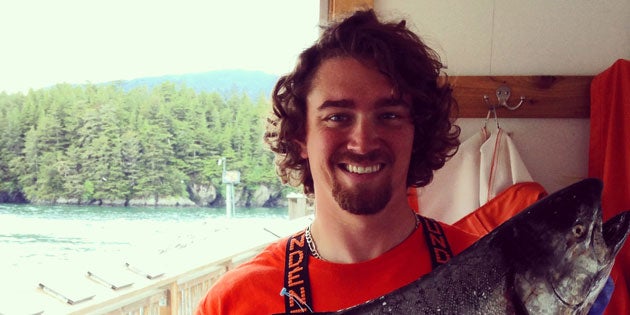Zach Brooker, a rising senior at the College of Charleston, is living out his dream this summer.
A biology major and environmental studies minor, Brooker is passionate about the environment and plans to become a wildlife biologist after graduation.
Besides his hometown of Charleston, Brooker couldn’t imagine a more perfect place to study the environment than Alaska. His summer internship at the Prince William Sound Science Center in Cordova, Alaska, runs May 15, 2014, through the end of August.
Brooker recently answered a few questions about his incredible summer of learning.
Q: How did you learn about the internship?
A: I actually had this internship come across my desk via Dr. Gorka Sancho, one of my favorite biology professors at the College. When it came across my desk, I pretty much laughed it off because I thought I’d never get it. Then next thing I know I’m buying a ticket to Alaska for the summer!
Q: Where are you and what does your internship entail?
A: I am working as a fish biologist/technician at the Prince William Sound Science Center (PWSSC). PWSSC is a nonprofit science organization that was created in response to the 1989 oil spill disaster in Valdez, Alaska. The Science Center has a fantastic team of biologists, chemists, oceanographers, and many other important players that make it an efficient and productive organization. My job is involved with a salmon study known as Hatchery Wild. Hatchery Wild is divided by habitats into ocean and stream “teams.” I work on the ocean side of the study, where the purpose is to catch salmon out in the sound, via a contracted gill-netter, and bring them in for examination to determine their origin and other morphometric data.
The hatcheries in the area are able to thermally mark all hatchery fish by keeping the water temperatures constant for a specific interval of time. This data is then recorded into the fish’s otoliths (ear bones) and can be used to evaluate whether the fish came from a hatchery, and if so, which specific hatchery. We collect four different measurements on each salmon, a total weight, extract otoliths, and also determine sex and weight of the gonads. All of this data will continue to provide indication of the health of the salmon population within Prince William Sound. This study will provide further evidence to understand how hatchery raised fish interact with wild populations and may allow for a better understanding of the effects that releasing more fish could have before it is done.
RELATED: Learn more about the College’s academic programs in biology and related minors.
Q: Where do you live and have you been able to explore your surroundings?
A: I am living just outside of town in a trailer that the Science Center owns and has dubbed, “The Bunkhouse.” It really is a luxurious trailer in comparison to the others in the surrounding area. I have four roommates, all of whom are very friendly and enjoyable to be around. But I am very limited in my ability to travel because I have no car.
When I first arrived my boss loaned me her car a lot, and I was able to do quite a bit of hiking. I have walked on glaciers, climbed a mountain or two, and even gotten a chance to walk through the Copper River Delta alongside the Eyak River.
I’ve also had two other great opportunities come my way via other employees with the science center. Our contract fisherman graciously offered to take my co-worker and I on a fishing trip with him on his 32’ bow-picker. This gave me the chance to experience the Alaskan fishing industry firsthand, and I learned all that a fisherman must do in order to be successful. Along with that I was able to see the East side of Prince William Sound from the water and all that it has to offer, including Humpback whales, Harbor and Dahls Porpoises, Stellar Sea lions, Puffins, and even a female Grizzly and her two cubs on the beach. It was amazing!
I was asked by another Science Center employee if I wanted to tag along on an aerial herring survey. We flew across the Sound and I got the opportunity to see the West side of the sound from a Sesna-185 and that too was fantastic. I learned how to spot schools of Herring from the air as well as how to estimate their age and size.
Q: How will this internship experience help you pursue your academic and career goals?
A: This internship has provided me with great hands-on field and lab experience. It is my first experience in conducting a large-scale biological study. The grant that funded this study was in excess of $4 million. I’ve learned many new tips pertaining to data entry and about data keeping in general. I’ve also had the opportunity to do a bit of teaching about salmon while I’ve been here as well. I have been involved in many volunteering opportunities, including the coveted Copper River Nouveau Science Center fundraiser, and the late summer Salmon Jam. I’ve gained experience working alongside and cooperating with state and federal wildlife departments, too. Overall this experience has been great for my career path to becoming a fish and wildlife biologist.
This internship demonstrates my dedication to becoming a biologist as I’ve traveled half a world away for this amazing opportunity. I’ve made many new friends and been able to extend my network farther than I could have ever imagined.








